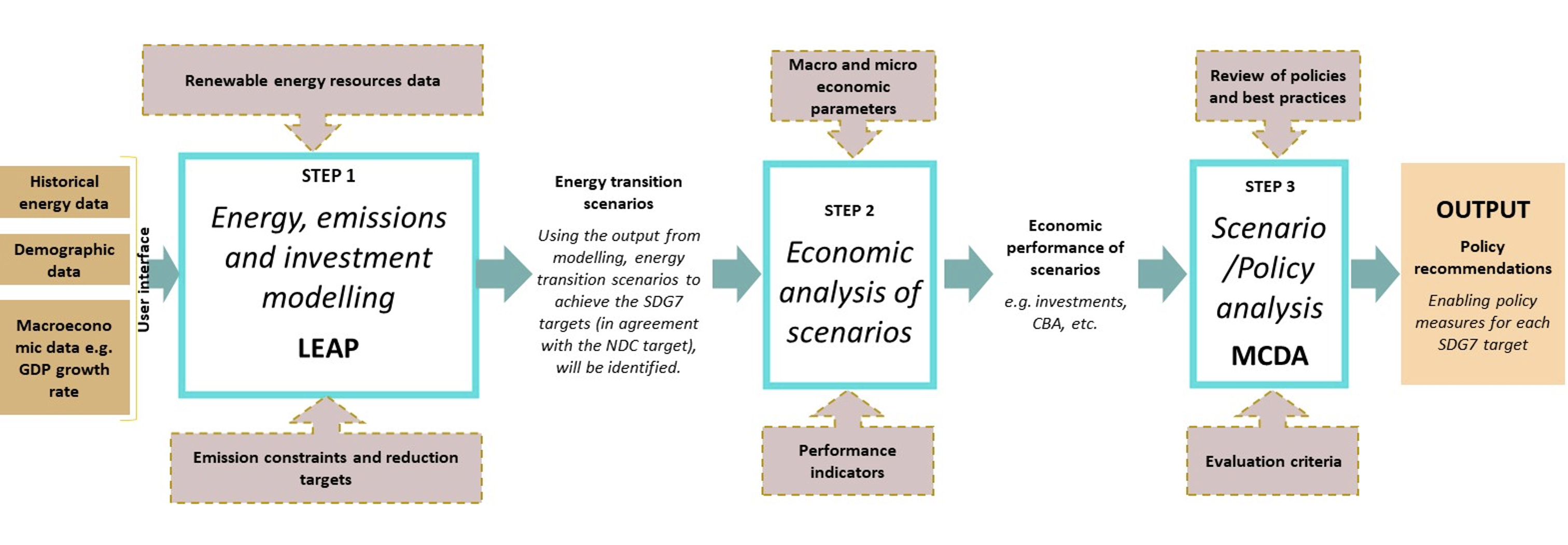html content
The main purpose of NEXSTEP is to help design the type and mix of policies that would enable the achievement of the SDG 7 targets and the emission reduction target (under NDCs) through policy analysis.
The NEXSTEP framework helps modelling energy, emissions and economics to analyse a range of policies and options for their suitability. This framework is unique in a way that no other tools look at developing policy measures to achieve SDG 7. One key feature is a back casting approach to energy and emissions modelling, which is important in planning for SDG 7 where the trajectory is developed backwards from the (known) 2030 targets to the present day. The methodology has been peer-reviewed by a panel of external experts. The panel members provided very positive feedback with recommendations for a few minor adjustments.

The scenario analysis evaluates and ranks scenarios, using the Multi Criteria Decision Analysis (MCDA) tool, with a set of criteria and weights assigned to each criterion. Although the criteria considered in the MCDA tool can include the following, stakeholders may wish to add/remove criteria to suit the local context:
• Access to clean cooking fuel;
• Energy efficiency;
• Share of renewable energy;
• Emissions targets in 2030;
• Alignment with the Paris Agreement;
• Fossil fuel subsidy phased out;
• Price of carbon;
• Fossil fuel phase-out;
• Cost of access to electricity;
• Cost of access to clean cooking fuel;
• Investment cost of the power sector; and
• Net benefit from the power sector.
This step is performed using the NEXSTEP online portal as a means to suggest the best way forward for the countries by prioritizing the scenarios. Stakeholders can update this scenario ranking by using a different set of criteria and their weights. The top-ranked scenario from the MCDA process is used to inform the Government on the best possible energy transition pathway for the country.
The NEXSTEP framework helps modelling energy, emissions and economics to analyse a range of policies and options for their suitability. This framework is unique in a way that no other tools look at developing policy measures to achieve SDG 7. One key feature is a back casting approach to energy and emissions modelling, which is important in planning for SDG 7 where the trajectory is developed backwards from the (known) 2030 targets to the present day. The methodology has been peer-reviewed by a panel of external experts. The panel members provided very positive feedback with recommendations for a few minor adjustments.

Energy and emissions modelling
NEXSTEP begins by developing a model of the energy system for each scenario, defining the technical options in terms of the final energy (electricity and heat) requirement for 2030, possible generation/supply mix, emissions and the size of investment required. The energy and emissions modelling component uses the Low Emissions Analysis Platform (LEAP) tool. This proprietary software is used by many countries to develop scenarios for the energy sector, policy analysis and develop NDC targets.Economic analysis
The second step builds on the selection of appropriate technologies through an economic optimisation process which identifies the least-cost energy supply options for the country. A comparative assessment of selected power generation technologies is done using the Levelized Cost of Electricity (LCOE) as an economic indicator. This provides policymakers with insights into the costs and benefits of the economically attractive technology options, allowing better allocation of resources and better-informed policy decisions. While the economic analysis has been kept at a simple level, it contains enough information to support policy recommendations in this Road Map. Some key cost parameters used in this analysis are (a) capital cost, including land, building, machinery, equipment and civil works, and (b) operation and maintenance cost, comprising fuel, labour and maintenance costs.
Scenario analysis
The scenario analysis evaluates and ranks scenarios, using the Multi Criteria Decision Analysis (MCDA) tool, with a set of criteria and weights assigned to each criterion. Although the criteria considered in the MCDA tool can include the following, stakeholders may wish to add/remove criteria to suit the local context:• Access to clean cooking fuel;
• Energy efficiency;
• Share of renewable energy;
• Emissions targets in 2030;
• Alignment with the Paris Agreement;
• Fossil fuel subsidy phased out;
• Price of carbon;
• Fossil fuel phase-out;
• Cost of access to electricity;
• Cost of access to clean cooking fuel;
• Investment cost of the power sector; and
• Net benefit from the power sector.
This step is performed using the NEXSTEP online portal as a means to suggest the best way forward for the countries by prioritizing the scenarios. Stakeholders can update this scenario ranking by using a different set of criteria and their weights. The top-ranked scenario from the MCDA process is used to inform the Government on the best possible energy transition pathway for the country.
